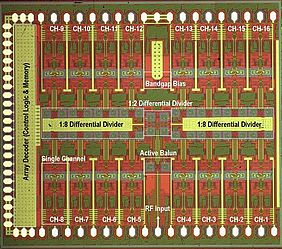At the Mobile World Congress, in Barcelona, Intel has presented a new millimetre antenna based on an array of antennas supporting communications in the Gbps range per single user.
These antenna are called "millimetre" because they work in the 28-50 GHz (if you do the math, the wavelength is below 1 cm when you are working at frequencies over 30 GHz... remember: c=f*λ). Increasing the frequency allows more bits to be transported but, there is always a "but", propagation becomes trickier since the shorter waves "bumps" onto many obstacles and fade away.
To counteract these propagation issues researchers are using arrays of antennas, rather than sending the signal through one single antenna they use many antennas at the same time so that the probability to go through increases (actually it is quite more complex than going through, it is about signal processing and signal reconstruction...).
This is not new, since we already have antennas array (you got one in you smart phone probably and one in your WiFi at home) and it is not even new in the area of millimetre communications (UC San Diego developed a complex array antenna chip back in 2007, see photo). What is new is that technology is now made available in a sugar box size at an affordable cost by Intel (and Samsung is following up).
It is this economic and industrial affordability that will be changing the wireless scenario in the coming years. These antennas will complement existing ones to morph LTE into 5G by the end of this decade. One antenna per city block will be capable of sustaining 10 times the present capacity in a much smaller cell, thus effectively multiplying the overall edge capacity by at least two orders of magnitude.
The nice side effect will be lower battery consumption (not dramatically lower since the higher frequency requires faster chips, hanse more power consumption, although the shorter radio link will decrease the power need for communications. Since the processing power increases linearly -almost- and the communications power decreases by the square of distance -roughly- there will be an overall energy budget decrease).
This is an area where the big industries, Intel, Samsung, Huawei and Nokia, to name a few, are hard at work.
As EIT ICT LABS we also have a stake in this future communications scenario, although we cannot target what industry is doing but, my personal take, should limit our focus on the edges and on the software mirroring of the edges (SDN: Software Defined Network) to provide a fabric for innovation made by start ups and small enterprises.







